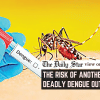Enforce science-based dengue control

The dengue situation is once again taking a worrying turn. With over 34,000 infections and 137 deaths recorded so far this year, the urgency cannot be overstated. In the first week of September alone, more patients were admitted to hospitals compared to the first weeks of July and August. At least 13 people have already died, while 2,383 were hospitalised during this period. Experts warn that August's rain, unchecked mosquito breeding, and weak anti-mosquito drives have contributed to this surge. If this trend continues, the coming weeks could see another deadly outbreak.
Particularly troubling is the sharp rise in cases outside Dhaka. Surveys by the DGHS, IEDCR, and CDC have all confirmed the widespread presence of Aedes albopictus, or the Asian tiger mosquito, in districts such as Khulna, Chattogram, Barishal, Jashore, and Faridpur. Unlike Aedes aegypti, the principal dengue carrier that mostly breeds in urban settings, albopictus thrives in natural and man-made containers alike, making control far more challenging. Its growing dominance in rural and semi-urban areas has made the spread of dengue increasingly unpredictable. Meanwhile, Dhaka's mosquito-control efforts remain largely ineffective despite spending around Tk 707 crore in the last nine years. Both city corporations continue to rely heavily on fogging and insecticide spraying, though entomologists have long warned that these methods bring little long-term benefit. A significant portion of annual budgets is spent on insecticide purchases, while sustainable strategies such as integrated vector management, biological larvicides, and coordinated community drives receive little attention. As a result, annual outbreaks persist.
Experts have repeatedly stressed the need to treat dengue as a year-round public health threat. This requires continuous mosquito surveillance, accurate reporting of infections, and stronger district-level health facilities. Currently, DGHS data comes from only a fraction of hospitals, leaving the true scale of infections unclear. Making dengue a notifiable disease, with mandatory reporting from all healthcare providers, is therefore essential. High-incidence areas also need sustained drives to destroy adult mosquitoes and breeding sites. Construction sites, drains, and water storage containers must be monitored regularly, while communities should be mobilised through awareness campaigns to do their part properly. Climate change is shifting the timing of peak infections and expanding mosquito breeding grounds. Unless outdated measures are replaced with science-driven, long-term strategies, Bangladesh will remain trapped in this cycle of preventable tragedy every monsoon.

 For all latest news, follow The Daily Star's Google News channel.
For all latest news, follow The Daily Star's Google News channel. 









Comments